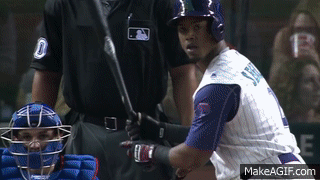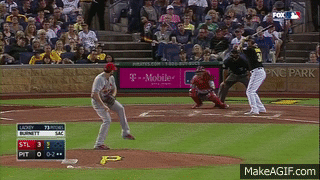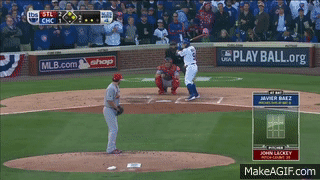It’s been weird, following the John Lackey story for the last few years. He was the villain of baseball, and just when you thought he couldn’t be any worse he totally redeemed himself—pitching well for the Red Sox to help them clinch their third World Series this millennium. He found his way to St. Louis and put up career numbers last year at the age of 36. Here are some notes in the BP Annual prior to the 2015 season:
“When the Red Sox signed Lackey to his windfall five-year deal prior to the 2010 season, they wrote in some protection in the form of a team option at the league minimum should he miss significant time with an elbow injury. Fast forward to the easiest decision John Mozeliak has ever made, as the Cardinals exercised Lackey’s option this year and will benefit from his veteran steadiness and league-average production for a cool $500k. The big right-hander has never been dominant but remains a premier strike-thrower who slots comfortably into the middle of a rotation. His bulldog demeanor and postseason heroics play well in the heartland. Midway through his Boston career, who could have imagined Google would someday auto-complete ‘John Lackey is’ with the phrase ‘the poster boy for redemption?’”
Curiosity got the best of me, but I can confirm:
Lackey has been an enigma, wrapped in a perplexity, topped with a cowboy hat. He’s not the most cuddly of players and has a face only a mother can love. The tall tales about Lackey have reached epic proportions, and if you don’t know what that means just give #LackeyFacts or #LackeyTips a search on Twitter.
By now Cubs fans know their Lackey history fairly well, but it’s worth retelling the interesting parts: He started with the then-Anaheim Angels, won game seven of the World Series in his rookie year, signed a big contract with Theo Epstein’s Red Sox, pitched horribly, had Tommy John Surgery, pitched great, won another World Series, reestablished himself as a premier pitcher with his career year in St. Louis, and finally signed a two-year deal with the Cubs last offseason that will pay him $32 million for his age 37 and 38 seasons.
Despite the fact that Cubs fans had a bad taste in their mouth from watching Lackey pitch twice against the Cubs in the playoffs last year—not to mention the 21 2/3 innings he tossed in three starts against them in the regular season, totaling a 1.23 ERA—many grew to accept Lackey in blue pinstripes. But then he allowed a home run to slap-hitting shortstop Jean Segura on his first pitch of the 2016 season. In total, he allowed three earned runs in the first inning of his first Cubs game against the Arizona Diamondbacks. Who is this John Lackey, and where was the Cubs-killer that got a standing ovation after pitching his heart out in the clinching game of the 2013 World Series?
He’s still there, but as with all complicated humanoids it requires digging to get to the heart and soul. Lackey is like an onion—he has layers, and also will make you cry. In spite of my burning eyes, I dug into the problems that he has had with the first inning the last few years.
Lackey has totaled 95 starts since 2013, with a 3.39 ERA in 618 innings pitched. Over that span, he has a 2.1 BB/9, 7.4 K/9, and a 1.1 HR/9. All very solid numbers. But when you isolate to just the first innings of those 95 baseball games, Lackey’s ERA jumps to 4.19, while keeping a 2.1 BB/9 and 1.1 HR/9, and raising his K/9 to 8.2. That’s a bit confusing. Has it just been bad luck?
It could seem that way, but I suspected there was something deeper at the root of the problem—hidden underneath a crusty layer of beef jerky, chewing tobacco, and Clint Eastwood movies. Since 2013, Lackey has thrown 67 percent of his pitches for strikes, with his first inning strike percentage coming in at a nice clean 69 percent. So no problems with his control, right? Wrong.
Digging past more of the metaphorical gunk and fake stories about sound-proofing rooms in a home, I isolated 13 bad first innings in which Lackey allowed two or more runs. And that’s where we find the numbers that tell the story of John Lackey, baseball thrower. His strike percentage remained somewhat consistent at 66 percent in those 13 innings but he had plenty of bad secondary numbers, including 5.5 BB/9 and 4.8 HR/9 in those games.
Just because a pitcher is able to continue to throw roughly the same amount of strikes doesn’t mean that his control is on point. Lackey doesn’t have the pure heat or amazing stuff to just blow away or baffle hitters. He needs to be accurate in hitting his spots, or he’s going to end up giving up big home runs on the outside portion of the plate to some hacker.
It’s impossible to narrow down for every single game whether Lackey was hitting the spots where the pitches were called by his catcher without examining the video. We can’t look possibly look at every pitch he’s thrown over the last three-plus seasons, but we certainly can point out a few examples.
Notice where Miguel Montero calls for the ball with his glove and where Lackey’s pitch ends up on the first-pitch homer to Segura in Arizona.
It’s the same story on a pitch from Lackey to former Pirates pitcher A.J. Burnett last season. Yadier Molina calls for a low fastball, Lackey misses—in the strike zone—and leaves it up.
And for fun, last year Lackey also missed poorly on his last pitch of the season.
Taking those bad 13 first innings out of Lackey’s stat line drops his ERA in that period from 3.39 to 3.00. Lackey is, in general, a classic ‘get him early’ type of pitcher. It doesn’t mean, of course, that he won’t make a mistake later in the game—we saw this with Baez. But the biggest key to success in Lackey’s Cubs career will be his ability to get a feel for his pitches early in his games and get the ball where he wants it to go.
Lead photo courtesy Matt Marton—USA Today Sports.





Well done — a fun read, with strong analysis. Loved the Clint Eastwood line.
Thanks Joel! I appreciate you reading.
Little late reading this one, but that was a nice breakdown of Lackey. Nice work, Ryan, and something to watch for moving forward!